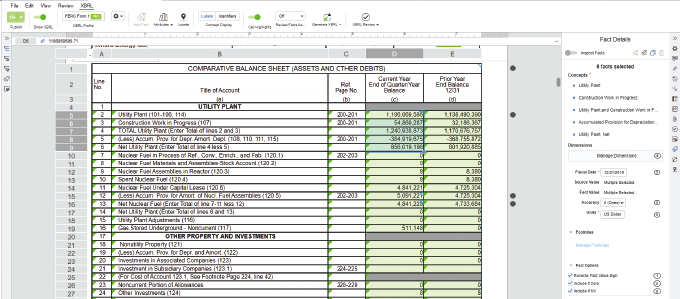By Percy Hung and Peter Larison, Workiva
Energy companies will soon start reporting quarterly and annual financial and operational data in XBRL format to the Federal Energy Regulatory Commission (FERC). The XBRL format isn’t new for public companies that have been submitting reports with XBRL tags to the Securities and Exchange Commission (SEC) for years, but the taxonomy for tagging FERC forms will be different.
TIME TO EVALUATE YOUR OPTIONS
In many respects, the burden should be lighter for FERC filers than SEC filers. Both will rely on the XBRL 2.1 Specification (which defines the basic building blocks of XBRL implementation in business reporting) and the Arelle open-source XBRL validation engine. And a “fact” in both reports is represented by a value (numeric or non-numeric), elements, date, unit, and accuracy.
But, as we detail below, you’ll notice quite a few differences with FERC’s XBRL requirements.

SIMPLIFIED ELEMENT SELECTION
Standard schedules allow for highly prescriptive tag assignments. That means no more tagging from scratch. For example, the Workiva solution for FERC reporting provides users with pre-tagged forms. These standardized pre-tagged forms not only reduce preparation efforts significantly, they also minimize tagging inconsistencies—you can achieve higher data quality with less effort.
Also, you are not required to tag every number. Notes to financial statements require block tags only. For example, if disclosure notes are pasted into FERC Form 1 from the 10-K you file with the SEC, those would be tagged with a single text block for FERC. A bonus for users of the Workiva solution for SEC reporting and the Workiva solution for FERC reporting: You will be able to link information in your 10-K to your pre-tagged Form 1 for consistency and efficiency.
If no applicable XBRL concept is available, the information is not to be tagged. However, if an applicable concept exists, FERC requires the information to be tagged (both numeric and nonnumeric). Note that some required information may be reported within footnotes for schedules.
Additionally, no extensions are allowed. Besides concepts, axes and members are also to be used as provided. So, how do you report company-specific information, such as officer names? In order to support reporting of company-specific information, FERC uses the typed dimension.
The bonus for Workiva users? Although FERC uses a different technical specification, you will see the Workiva FERC reporting solution offers the same look and feel as axis/member application in the Workiva solution for SEC reporting.
NO OUTLINE MANAGEMENT OR CUSTOM DATES
For FERC reporting, no custom labels or label roles are needed. Labels are auto-assigned by the official FERC renderer based on form locations. Also, there are no calculation to define. In fact, custom calculations are not permitted. Validation rules will handle consistency checks.
Since FERC taxonomy assigns specific hypercube to each schedule, there is no outline structure to build. For users of Workiva for FERC reporting, this is automatically managed by the Workiva platform.
Plus, fact ordering is not controlled by the outline and is not required. FERC uses a numeric element “OrderNumber” to control sequencing of company-specific information. Users of the Workiva solution for FERC reporting can easily assign row numbers in the form schedules as “OrderNumber” in the Workiva platform. Lastly, there are no custom dates as you’re limited to a small list of allowable values.
SUBMISSION OF DATA AS INSTANCE DOCUMENT ONLY
Going forward, there is no digital form to submit. Machine-readable data is the key focus. Although not in iXBRL format, FERC’s official form renderer will provide standardized viewing for the submitted XBRL data.
SUPPORTS REQUEST FOR CONFIDENTIAL DATA
Since most filing data to the SEC is public record, the SEC doesn’t offer this, but FERC does. Whether FERC will actually approve a request for confidential data is another question! If you have an XBRL vendor for SEC reporting, make sure your vendor also supports FERC compliance, since the FERC taxonomy will not be the same as the SEC reporting taxonomy.
PREPARE FOR YOUR NEEDS
Whether you outsource XBRL tagging, choose an XBRL software vendor, or invest the time and money to build and maintain an in-house solution for FERC compliance, understanding the similarities and differences between XBRL filings for FERC and for the SEC will be crucial when evaluating your options.
FOR MORE INFORMATION
Percy Hung is director of structured data initiatives and Peter Larison is manager of structured data initiatives at Workiva. Workiva, Inc. is a global software-as-a-service company. It provides a cloud-based connected and reporting compliance platform that enables the use of connected data and automation of reporting across finance, accounting, risk, and compliance. For more information, visit www.workiva.com.
MODERN PUMPING TODAY, July 2022
Did you enjoy this article?
Subscribe to the FREE Digital Edition of Modern Pumping Today Magazine!


